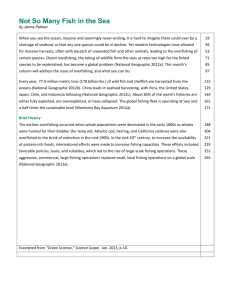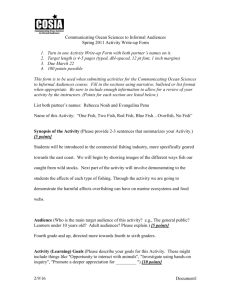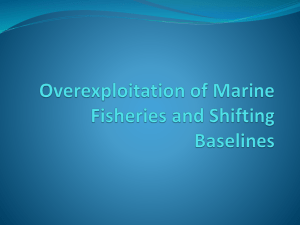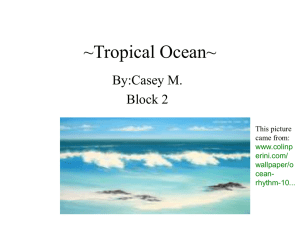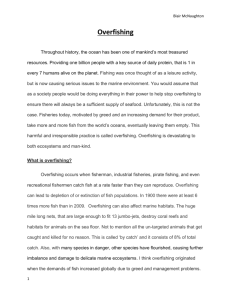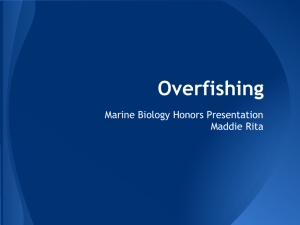Overfishing_final
advertisement
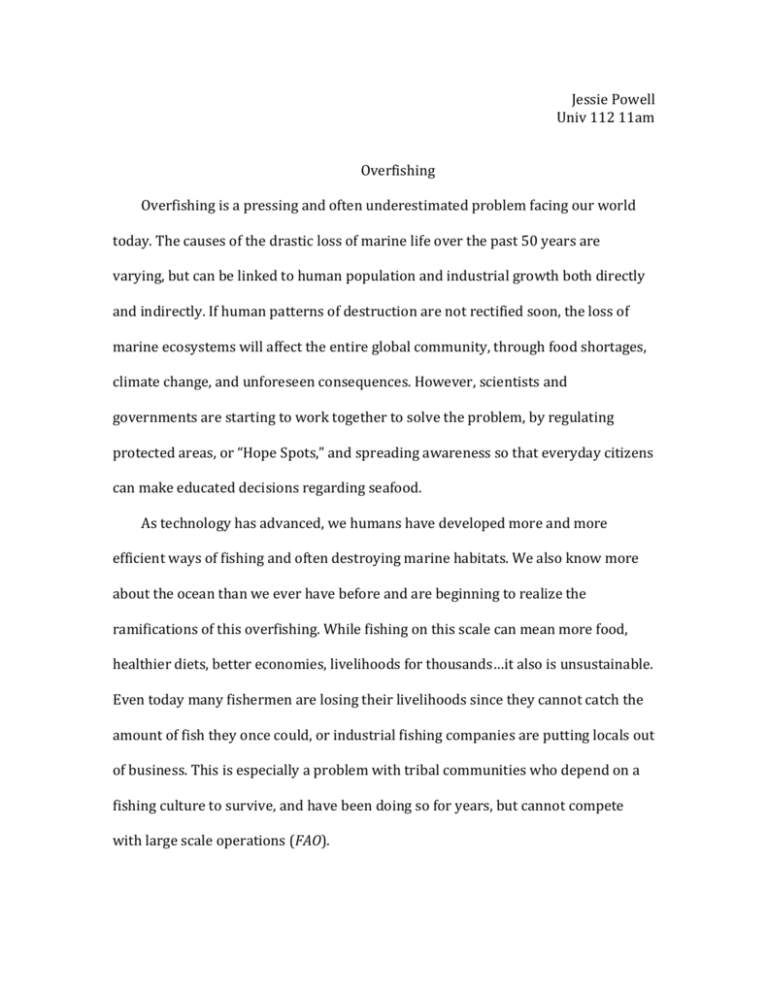
Jessie Powell Univ 112 11am Overfishing Overfishing is a pressing and often underestimated problem facing our world today. The causes of the drastic loss of marine life over the past 50 years are varying, but can be linked to human population and industrial growth both directly and indirectly. If human patterns of destruction are not rectified soon, the loss of marine ecosystems will affect the entire global community, through food shortages, climate change, and unforeseen consequences. However, scientists and governments are starting to work together to solve the problem, by regulating protected areas, or “Hope Spots,” and spreading awareness so that everyday citizens can make educated decisions regarding seafood. As technology has advanced, we humans have developed more and more efficient ways of fishing and often destroying marine habitats. We also know more about the ocean than we ever have before and are beginning to realize the ramifications of this overfishing. While fishing on this scale can mean more food, healthier diets, better economies, livelihoods for thousands…it also is unsustainable. Even today many fishermen are losing their livelihoods since they cannot catch the amount of fish they once could, or industrial fishing companies are putting locals out of business. This is especially a problem with tribal communities who depend on a fishing culture to survive, and have been doing so for years, but cannot compete with large scale operations (FAO). Overfishing began with the slaughtering of countless whales for blubber for lamp oil in the 1800s, and continues today with the decimation of many more species. In the past 50 years alone 90% of large ocean fish populations, such as orange roughy, Chilean sea bass, bluefin tuna, as well as many shark species have been depleted (National Geographic). This affects the entire ocean ecosystem, since these are the big predators often times. The fishing companies use technologies that gather fish and other byproduct species at such a rate that they cannot replenish in time; technologies such as long lines with baited hooks every few feet – stretching up to 50 miles, industrial trawlers and draggers that move along the sea floor and destroy everything in their way, vacuums that suck up hundreds of fish in just minutes, the use of explosives, and “ghost fishing” are all a part of the problem. One of the most wasteful things about these fishing strategies is the amount of byproduct. This means that for every load brought on shore from a trawler, for example, up to 80 or 90% of the marine life caught is not the target species, and is thrown overboard again, already dead. When sharks are caught, their fins are cut off and the sharks’ bodies are thrown overboard to die – a form of byproduct fishing. “Ghost fishing,” another issue, is when animals get caught in abandoned nets or traps and are left to suffocate or starve for no reason (Mission Blue). All of this is done to feed the growing global population of humans. Sometimes this is indirect, such as when it comes to killing anchovies and sardines for their oils, or feeding kelp to cattle, destroying an entire kelp habitat in the process (Mission Blue). One solution is thought to be farm fishing, or aquaculture; there are issues surrounding this industry as well, though. Many times the coastal region where a farm is going to be put in place is destroyed, including mangrove forests housing bird and crab species, natural bunkers against storms, and sometimes human homes. Fresh water sources are drained to lower the salinity of the farm’s water, which can displace people who rely on those water sources. Wastewater is dumped into surrounding natural habitats, which can lead to algae blooms and make native fish ill since they are not given the antibiotics the farm fish are (WWF). Although farm fishing can solve the problem of overfishing the ocean’s native populations, it needs more regulation to prevent it causing more problems than it solves. The ocean is Earth’s circulatory system in many respects; it regulates our climate, CO2 levels, and is involved in every cycle (water, nitrogen, oxygen…) on Earth. If the life below the surface of the water is tampered with, the whole system could become skewed. Ecosystems only work if everything is in balance, and when one species is depleted, the entire food chain feels it – this is called a “trophic cascade.” Without cod and haddock, shrimp and capelin populations are expanding unhindered in the Northwestern Atlantic; without predators like tuna, anchovy populations are booming in the Black Sea; without predators, urchins are more prevalent on coral reefs, leading to erosion and decreased algal-feeding fish diversity (WWF). These are just a few examples of the ramifications of overfishing, but there are infinitely more. Much of the ocean remains unexplored to this day, so really it is impossible to know what and how everything will be affected by overfishing. Deep ocean creatures are often left out of the sustainability discussion, but are some of the most sensitive to environmental changes since they live in such a unique environment. It is in our best interest to reform the fishing industry so that it is sustainable, because if we eat all the fish we will not have any left, those currently employed by the industry will be unemployed, the jobs the oceans perform to regulate the Earth systems will collapse, and we will lose beautiful coral reefs and biodiversity. There is hope, however, for the oceans. Places where protective measures against fishing and pollution have been put in place (MPAs or Marine Protected Areas) have proven that with time, fish populations can recover. So far, only 3% of the world’s oceans are protected, but more action is starting to be taken (Mission Blue). In the US in 2000, an executive order was issued to encourage the “Department of Commerce, the Department of the Interior, and other federal agencies to work closely with states, territories, tribes, fishery management councils, and groups with an interest in marine resource conservation to develop a scientifically-based, comprehensive National System of MPAs representing diverse U.S. marine ecosystems” (NOAA). Since this order, the US has mandated several locations where the ocean is either fully protected, a no-take zone, or some other form of a marine sanctuary, such as the Marianas Trench Marine National Monument where scientists are still exploring new deep-sea discoveries. Globally, there are 57 “Hope Spots,” named so by prominent Marine Biologist Silvia Earle, where diverse marine habitats around the world are protected and have been successfully recovering. These Hope Spots can be found in every ocean, and range from tropical to arctic waters. These places are beneficial to humans in that they replenish collapsing food stocks for surrounding fishing waters, are CO2 sinks, allow sanctuaries for endangered species and juveniles to grow, maintain diverse and precious ecological habitats, and help preserve local traditions and livelihoods for cultures deeply linked to the ocean (WWF). As individuals, we can make educated decisions at the grocery store about what seafood and fish oil we buy, and be sure to know where it came from, as well as spread awareness. This is an ethical issue because there are many parties and interests involved, and there is not one clear answer to the problem. On one hand, the growing world population will always demand fish to eat, and fishermen will always need jobs. Yet this unsustainable pattern we have established will ultimately lead to the decimation of both of these things. So what to do? There needs to be a balance established between fishing areas and protected areas, fishermen need to respect the limits of the ocean, CO2 levels need to drop to prevent ocean acidification, and as individuals we need to become informed about these problems. Only if we are informed can we make ethical decisions. The fish have the right to live, yet humans have the right to eat. As with any ethical decision making process, all sides and all outcomes must be considered. In conclusion, recent decades have seen a dramatic decrease in global fish stocks due to the increase in industrial fishing and new fishing technologies that do not allow the fish populations time to replenish. The fish are not growing to be old enough to migrate to their usual places, food chains are being disrupted, and reefs are dying. This can be stopped now if more protected areas are mandated, such as the Hope Spots seen around the world today, where marine populations are given the chance to replenish. The ocean is crucial to the survival of every species on the planet, which is why it deserves to be protected. Citations Mission Blue. Hope Spots. Silvia Earle Alliance, 2015. Web. April 3, 2015. <http://mission-blue.org/hope-spots-new/> NOAA. The Road to End Overfishing: 35 Years of Magnuson Act. NOAA Fisheries. Web. April 3, 2015. m> <http://www.nmfs.noaa.gov/stories/2011/20110411roadendoverfishing.ht National Geographic. Overfishing. Web. April 3, 2015. <http://ocean.nationalgeographic.com/ocean/critical-issues-overfishing/> WWF. Unsustainable Fishing. Web. April 3, 2015. <http://wwf.panda.org/about_our_earth/blue_planet/problems/problems_fi shing/> FAO. Aquaculture. Web. April 27, 2015. <http://www.fao.org/aquaculture/en/>
